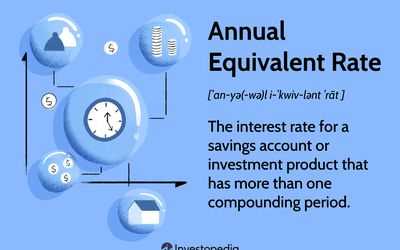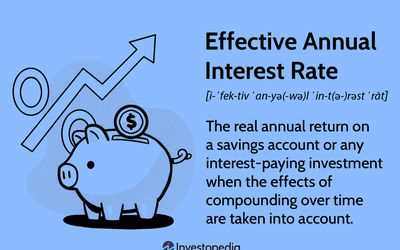What is Annual Equivalent Rate (AER)?

The Annual Equivalent Rate (AER) is a financial term used to calculate the interest rate on savings accounts. It is a standardized way of comparing different savings products and helps consumers make informed decisions about where to invest their money.
The AER takes into account the compounding of interest over a year and provides a clear picture of the overall return on investment. It allows consumers to compare savings accounts with different interest payment frequencies, such as monthly, quarterly, or annually.
The AER is particularly useful when comparing accounts with different interest rates and compounding frequencies. By calculating the AER, consumers can determine which account offers the best return on their investment.
To calculate the AER, the formula takes into account the nominal interest rate and the number of compounding periods in a year. The AER is calculated by adding 1 to the nominal interest rate, raising it to the power of the number of compounding periods, and subtracting 1. The result is then multiplied by 100 to express it as a percentage.
For example, if a savings account has a nominal interest rate of 5% and compounds interest annually, the AER would be calculated as follows:
This means that for every £100 deposited into the account, the account holder would earn £5 in interest over the course of a year.
Definition of Annual Equivalent Rate (AER)
The Annual Equivalent Rate (AER) is a financial term used to describe the interest rate that would be earned on a savings account over the course of a year, taking into account the effect of compounding. It is a standardized way of comparing different savings accounts and allows consumers to easily compare the potential returns on their savings.
The AER takes into consideration the frequency at which interest is paid and compounds it annually. This means that if interest is paid monthly, the AER will reflect the effect of compounding over the course of a year. The AER allows consumers to make informed decisions about their savings by providing a clear and consistent measure of the potential returns on their investment.
The AER is regulated by financial authorities to ensure that it is calculated and advertised accurately by financial institutions. This helps to protect consumers and ensure that they are provided with clear and transparent information when comparing savings accounts.
In summary, the Annual Equivalent Rate (AER) is a standardized measure of the potential returns on a savings account over the course of a year, taking into account the effect of compounding. It allows consumers to compare different savings accounts and make informed decisions about their savings.
Formula for Calculating Annual Equivalent Rate (AER)
The Annual Equivalent Rate (AER) is a formula used to calculate the effective annual interest rate on a savings account. It takes into account the compounding of interest over a given period of time, allowing for easy comparison between different savings accounts.
The formula for calculating the AER is as follows:
- Step 1: Divide the annual interest rate by the number of compounding periods in a year. For example, if the annual interest rate is 5% and interest is compounded monthly, divide 5% by 12.
- Step 2: Add 1 to the result from Step 1.
- Step 3: Raise the result from Step 2 to the power of the number of compounding periods in a year. In the example above, raise the result from Step 2 to the power of 12.
- Step 4: Subtract 1 from the result from Step 3.
- Step 5: Multiply the result from Step 4 by 100 to convert it to a percentage.
Here is the formula in mathematical notation:
For example, let’s say you have a savings account with an annual interest rate of 5% and interest is compounded monthly. Using the formula, the calculation would be as follows:
- Step 1: 5% / 12 = 0.4167%
- Step 2: 1 + 0.4167% = 1.004167
- Step 3: 1.004167 ^ 12 = 1.051167
- Step 5: 0.051167 * 100 = 5.1167%
Therefore, the AER for this savings account would be 5.1167%.
The AER allows individuals to compare the true returns on different savings accounts, taking into account the compounding of interest. It is an important tool for making informed decisions about where to save money.
Examples of Annual Equivalent Rate (AER) in Savings Accounts
Example 1: Basic Savings Account

Example 2: High-Yield Savings Account
Example 3: Tiered Savings Account

Some savings accounts offer tiered interest rates based on the amount deposited. For example, a tiered savings account may have an AER of 1% for deposits up to $5,000 and an AER of 2% for deposits above $5,000. If you deposit $7,000 into this account, the AER will determine the interest earned over a year. The first $5,000 will earn 1% interest ($50), and the remaining $2,000 will earn 2% interest ($40), resulting in a total interest earned of $90.

Emily Bibb simplifies finance through bestselling books and articles, bridging complex concepts for everyday understanding. Engaging audiences via social media, she shares insights for financial success. Active in seminars and philanthropy, Bibb aims to create a more financially informed society, driven by her passion for empowering others.
